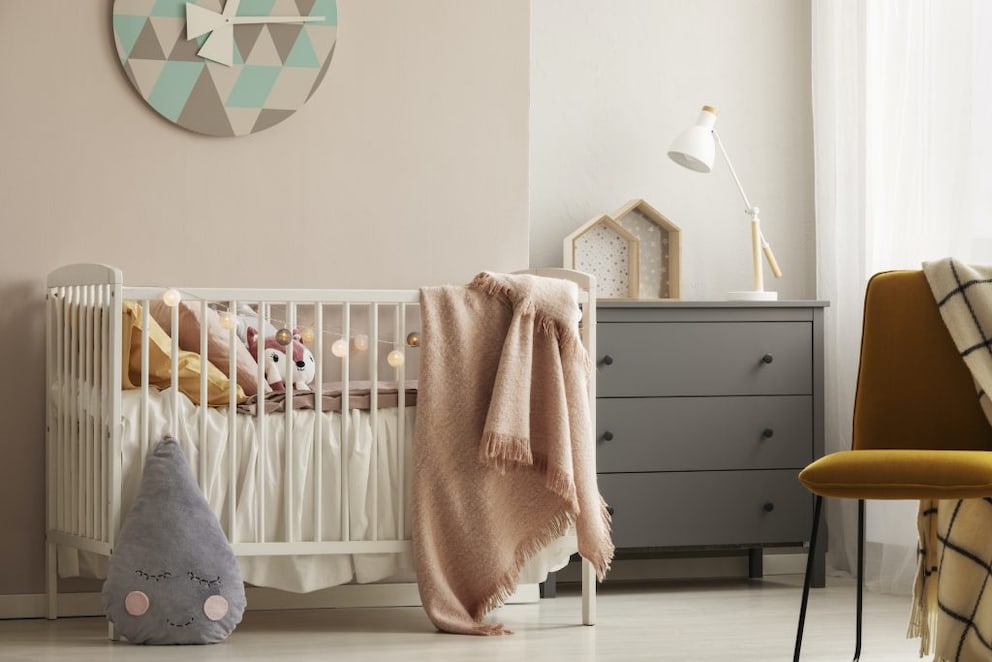July 7, 2025, 10:55 am | Read time: 6 minutes
If children are restless and unfocused, it might be due to the setup of their bedroom. Arranging the room according to the Chinese energy principles of Feng Shui can naturally create more calm and balance in the space.
The well-being of their children is the most important thing for parents. This is often reflected in the design of the children’s room, which is increasingly being made more sustainable and with significantly less plastic toys. A setup that promotes balance and calm in the children’s room is the traditional Chinese energy practice of Feng Shui. Don’t worry: You don’t have to delve into the depths of esotericism to positively influence your child’s well-being.
Importance of the Children’s Room
The children’s room is still a relatively “young” space, only becoming common in the 20th century. Children used to sleep in the parents’ room and played outside in the yard or nature. Today, a child usually has their own little domain from birth.
Small is the right word here, as children are typically given the smallest room in the house. This is problematic because a children’s room often needs to integrate multiple functional areas. It’s a place for playing, learning, and sleeping, all of which require sufficient space. However, this space is often maximally filled with a vast amount of clothing, toys, and school supplies. Due to this inherent chaos, the Chi, or life energy, can flow poorly in this room. Therefore, arranging the children’s room according to Feng Shui is advisable.
Also interesting: Creative Wall Design for the Children’s Room – The Best Ideas
The Right Children’s Bed According to Feng Shui
Let’s start in order: Initially, a toddler only needs a bed for sleeping. Alongside the desk, this piece of furniture plays a significant role in Feng Shui. Ideally, the bed is made of wood, preferably stone pine, as its essential oils have a calming effect. Metal, on the other hand, is not a suitable choice for a children’s bed, as it conducts electricity and magnetic and electromagnetic fields. Even if the bed is partially made of metal or has an innerspring mattress, it is not conducive to a child’s sleep.
A loft bed is also viewed critically in Feng Shui, as it is often combined with a desk underneath, compressing two different energies in a small space. The calming Yin energy (sleep) meets the activating Yang energy (learning). Additionally, a loft bed lacks grounding, which is especially important for sensitive, dreamy, or shy children.
Position of the Children’s Bed in the Room
For a child to sleep well, calming Yin energy must flow at the bed’s location. This energy flows best in places free from radiation caused by water veins, Bluetooth, Wi-Fi routers, or electrical wiring within walls. Ideally, the bed’s headboard and one side should be against a wall, providing the child with a sense of protection. Additionally, if the child can see the room’s door and window from the bed, they will feel more secure.
However, avoid placing the children’s bed directly between the door and window, between two doors, or between multiple windows. These configurations create restless energy flows, making it difficult to find peace at night. If no other option is available, a room divider like a shelf or a large plant can help.
Type and Position of the Desk
According to Feng Shui, the type and position of the desk are crucial for the energy flow in the children’s room. If the Chi can flow freely, creativity, concentration, and motivation for learning will flourish. A position that blocks energy, especially on a mental level, is one with a direct view of a wall. Additionally, sitting with one’s back to the room causes discomfort and strains a child’s concentration.

A window should not be behind the child either, as this will make them feel unprotected and unable to focus. Like the bed, the desk should not be positioned between the door and window but rather in a way that allows both room elements to be in view when looking up. Ideal for a good overview and freedom of thought is a seating position with the back to the wall and a view into the room. Ideally, the desk should be made of solid wood, not metal or glass elements.
Neutral Colors and Natural Materials
The color scheme of a children’s room designed according to Feng Shui may initially seem paradoxical. For more balance in the room, neutral, soft tones are recommended. However, children tend to prefer bright colors. Bold colors like red, yellow, or blue are suitable for playing and romping during the day but are disruptive when it comes to a restful night’s sleep.

Sorbet tones like soft yellow, lilac, mint green, light gray, or sand are more suitable. If not used extensively on walls, floors, or curtains, small accessories can at least be striking in their color. This usually happens through a vast array of toys. Therefore, wild patterns should be used sparingly in the children’s room, with a preference for solid colors.
Warm wood tones and other natural materials are also optimal for a Feng Shui-style children’s room. Bedding, blankets, and covers should ideally be made of organic cotton, wool, and linen, as they do not become statically charged like synthetic fibers.
Also interesting: Setting Up the Children’s Room According to Montessori

Why You Should Avoid Having a Mirror in the Bedroom

6 Children’s Room Trends for 2025

Setting Up a Montessori-Inspired Children’s Room
Avoiding Chaos as Much as Possible
The inherent lack of order in a children’s room is natural. It’s a place for playing, romping, and learning. This should be visible to some extent. For more childlike balance and positive energy flow, regular tidying up in the evening is a must according to Feng Shui. Additionally, there are too many distractions in a children’s room. A bed covered with stuffed animals leaves a child restless due to lack of space, and a cluttered desk makes it difficult to concentrate while learning.
If practically every corner of the children’s room, as well as spaces under the bed and on cabinets, are overflowing, the Chi cannot circulate freely. It is also helpful to reduce the amount of toys, especially those that are unused or even broken. According to Feng Shui, a children’s room needs a certain structure: It is advisable to divide the room into three areas–sleeping, playing, and learning–create designated storage spaces for toys and learning materials, and label boxes accordingly.

